Chemical substances secreted by cells into the extracellular
fluids that regulate the metabolic function of other cells in the
body are called ________.
A) enzymes
B)
antibodies
C) proteins
D) hormones
D) hormones
True or False?
Direct gene activation involves a second-messenger system.
FALSE
True or False?
All peptide hormone synthesis requires gene activation that produces mRNA.
TRUE
Which of the following is not a change that may be caused by
hormonal stimulus?
A) a change in membrane
potential
B) direct control of the nervous system
C) the
stimulation of a genetic event resulting in protein synthesis
D)
an increase in enzymatic activity
B) direct control of the nervous system
The ability of a specific tissue or organ to respond to the
presence of a hormone is dependent on ________.
A) the location of the tissue or organ with respect to the
circulatory path
B) the membrane potential of the cells of the
target organ
C) the presence of the appropriate receptors on the
cells of the target tissue or organ
D) nothing all hormones of
the human body are able to stimulate any and all cell types because
hormones are powerful and nonspecific
C) the presence of the appropriate receptors on the cells of the target tissue or organ
Thyroid hormone (a small iodinated amine) enters target cells
in a manner similar to ________.
A) insulin,
because insulin is a small peptide
B) steroid hormones, because
both diffuse easily into target cells
C) growth hormone, because
the thyroid works synergistically with thyroid hormone
D)
glucagon, because the structure of glucagon is similar to that of
thyroid hormone
B) steroid hormones, because both diffuse easily into target cells
What ion is sometimes used as a second messenger of amino acid-based hormones?
A) chlorine
B) sodium
C) calcium
D) iron
C) calcium
True or False?
Both "turn on" factors (hormonal, humoral, and neural stimuli) and "turn off" factors (feedback inhibition and others) may be modulated by the activity of the nervous system.
TRUE
Virtually all of the protein or amino acid-based hormones
exert their effects through intracellular ________.
A) ions
B) deactivators
C) nucleotides
D) second messengers
D) second messengers
Which of the following is not a type of hormone interaction?
A) synergism
B) feedback
C) antagonism
D) permissiveness
B) feedback
Which of the following is not a change typically produced by a hormonal stimulus?
A) induces secretory activity
B) stimulates production of an
action potential
C) activates or deactivates enzymes
D)
alters plasma membrane permeability
B) stimulates production of an action potential
The second-messenger mechanism of hormone action operates by ________.
A) synthesizing more of the hormone than is actually needed
B)
increasing the basal metabolic rate in the target organ
C) not
responding to a feedback mechanism
D) binding to specific
receptors and employing the services of G proteins and cAMP
D) binding to specific receptors and employing the services of G proteins and cAMP
Cells that respond to peptide hormones usually do so through a sequence of biochemical reactions involving receptor and kinase activation. In order for cells to respond, it is necessary for first and second messengers to communicate. This is possible because ________.
A) peptide hormones always enter the cell membrane and elicit a
response without
assistance from other messengers
B)
hormones alter cellular operations through stimulation of a gene
directly
C) G protein acts as the link between first and second
messengers
D) the hormone receptor complex moves into the
cytoplasm as a unit
C) G protein acts as the link between first and second messengers
Cellular responses to hormones that initiate second-messenger
systems include ________.
A) possible
activation of several different second-messenger systems
B)
cyclic AMP phosphodiesterase formation of an active second
messenger
C) formation of a specific protein kinase that acts on
a series of extracellular intermediates
D) hormone binding to
intracellular receptors
A) possible activation of several different second-messenger systems
In circumstances where the body requires prolonged or
increased levels of a hormone, the DNA of target cells will specify
the synthesis of more receptors on the surface of the cells of the
target organ. This is known as ________.
A)
the cellʹs sensitivity reaction
B) cellular affinity
C)
up-regulation
D) a reaction to a stressor
C) up-regulation
True or False?
ACTH stimulates the adrenal cortex to release corticosteroid hormones.
TRUE
True or False?
LH is also referred to as a gonadotropin.
TRUE
True or False?
Oxytocin is a strong stimulant of uterine contractions.
TRUE
The hypothalamic-hypophyseal tract ________.
A) connects the hypophysis to the pituitary gland
B) is partly
contained within the infundibulum
C) conducts aldosterone to the
hypophysis
D) is the site of prolactin synthesis
B) is partly contained within the infundibulum
Oxytocin ________.
A) release is an example of a positive feedback control
mechanism
B) is an adenohypophyseal secretion
C) exerts its
most important effects during menstruation
D) controls milk production
A) release is an example of a positive feedback control mechanism
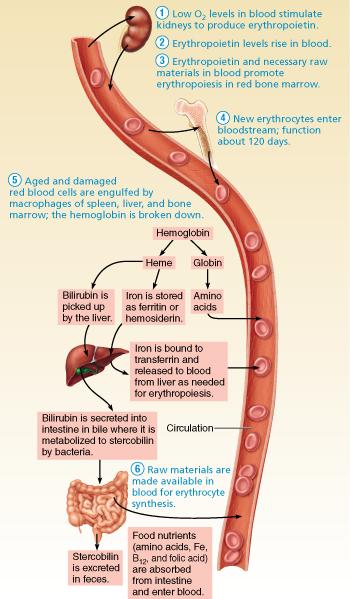
What role do the kidneys play in erythropoiesis?
The kidneys detect low levels of oxygen in the blood
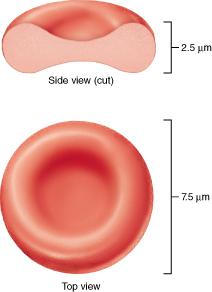
What triggers erythropoietin (EPO) production to make new red blood cells?
A) too many platelets
B) reduced availability of oxygen
C)
excess oxygen in the bloodstream
D) a high hematocrit
B) reduced availability of oxygen
What organ in the body regulates erythrocyte production?
A) Kidney
B) Brain
C) Liver
D) Pancreas
A) Kidney
True or False?
Peptides called NPY and AgRP are powerful appetite enhancers.
TRUE
True or False?
Ghrelin, produced by the stomach, is a powerful appetite stimulant.
TRUE
Many factors influence BMR. What is the most critical factor?
A) The ratio of surface area to volume (weight) of the body
B) The way skeletal muscles break down glycogen
C) The way an individual metabolizes fat
D) An individual's body weigh
A) The ratio of surface area to volume (weight) of the body
The amount of ________ produced is probably the most important hormonal factor in determining BMR.
A) norepinephrine
B) thyroxine
C) prolactin
D) ADH
B) thyroxine
True or False?
When blood glucose levels are low, the body begins to use more noncarbohydrate fuels for energy production. This process is called glucose activation.
FALSE
True or False?
The preferred energy fuel for the brain is fat.
FALSE
True or False?
The increased use of noncarbohydrate molecules for energy to conserve glucose is called glucose sparing.
TRUE
Glucose can be obtained from ________.
A) glycogenolysis
B) triglyceride anabolism
C) protein
anabolism
D) lipogenesis
A) glycogenolysis
Which of the choices below is not a source of glucose during the postabsorptive state?
A) Absorption of glucose from the GI tract
B) Lipolysis in
adipose tissues and the liver
C) Glycogenolysis in the
liver
D) Catabolism of cellular protein
A) Absorption of glucose from the GI tract
Which hormone directs essentially all the events of the absorptive state?
A) growth hormone
B) thyroid hormone
C)
epinephrine
D) insulin
D) insulin
Which of the choices below happens during the absorptive state?
A) Anabolic processes exceed catabolic ones.
B) Catabolic
processes exceed anabolic ones.
C) No metabolism occurs.
D)
Only glucose metabolism occurs.
A) Anabolic processes exceed catabolic ones.
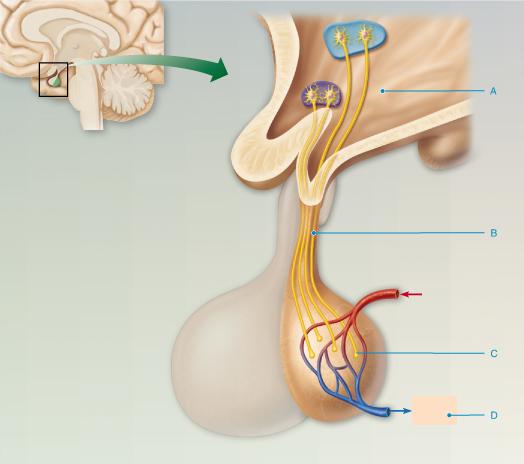
Where are oxytocin and antidiuretic hormone (ADH) made? Select from letters A-D.
A
Which of the following is not a category of endocrine gland stimulus?
A) enzyme
B) humoral
C) neural
D) hormonal
A) enzyme
Which of the choices below is not a factor required for target cell activation by hormone receptor interaction?
A) blood levels of hormone
B) type of hormone
C) number
of receptors for that hormone
D) strength of the bond between
the receptor and hormone
B) type of hormone
Which of the following is not a steroid-based hormone?
A) estrogen
B) aldosterone
C) epinephrine
D) cortisone
C) epinephrine
Eicosanoids do not include ________.
A) paracrines
B) leukotrienes
C) hydrocortisones
D) prostaglandins
C) hydrocortisones
Thyroxine is a peptide hormone, but its mechanism is different from other peptide hormones. Which of the following statements is true concerning this difference?
A) It causes positive feedback.
B) It does not require a
second messenger to effect a response.
C) It is very specific in
the cell type it targets.
D) It is a stimulant of cellular
metabolism and targets all cells.
B) It does not require a second messenger to effect a response.
Steroid hormones exert their action by ________.
A) entering the nucleus of a cell and initiating or altering the
expression of a gene
B) finding an appropriate cell receptor and
initiating cAMP activity
C) stimulating the synthesis of a
glycogen
D) increasing blood pressure
A) entering the nucleus of a cell and initiating or altering the expression of a gene
Hormones often cause a cell to elicit multiple responses; this is because ________.
A) there are thousands of receptors on the cell membrane
B)
the receptors bind to several hormones at the same time
C) the
protein kinases are rapidly metabolized
D) during protein kinase
activation, enzymes phosphorylate many other enzymes
D) during protein kinase activation, enzymes phosphorylate many other enzymes
One of the least complicated of the endocrine control systems directly responds to changing blood levels of ions and nutrients. Which of the following describes this mechanism?
A) the rapid oxidation of carbohydrates
B) catabolic
inhibition
C) protein synthesis
D) humoral stimulation
D) humoral stimulation
ADH ________.
A) increases urine production
B) promotes dehydration
C)
is produced in the adenohypophysis
D) is inhibited by alcohol
D) is inhibited by alcohol
Several hormones are synthesized in the hypothalamus and transported to the anterior pituitary gland. The mechanism of transportation from hypothalamus to anterior pituitary gland is through the ________.
A) hepatic portal system
B) general circulatory system
C)
hypophyseal portal system
D) feedback loop
C) hypophyseal portal system
The neurohypophysis or posterior lobe of the pituitary gland is not a true endocrine gland because ________.
A) it is strictly a part of the neural system and has little or
nothing to do with hormonal release
B) embryonically it was an
endocrine tissue, but in the adult human it is no longer
functional
C) it is unable to function as an endocrine tissue
because it is actually part of the neural system due to its
location
D) it is only a hormone storage area that receives
hormones from the hypothalamus for release
D) it is only a hormone storage area that receives hormones from the hypothalamus for release
The major targets of growth hormone are ________.
A) the blood vessels
B) the adrenal glands
C) the
liver
D) bones and skeletal muscles
D) bones and skeletal muscles
Regulating hormones from the hypothalamus ________.
A) enter venous circulation and travel to the heart, which pumps the
hormone-containing
blood to the pituitary
B) enter the
hepatic portal system, which feeds the pituitary
C) travel by
arteries to the pituitary
D) first enter into the hypophyseal
portal system
D) first enter into the hypophyseal portal system
Why does antidiuretic hormone help regulate an abnormal increase in solute concentration in the extracellular fluid?
A) It causes secretion of solutes by the kidney, resulting in a
decreased solute concentration.
B) It causes less reabsorption of
water by the kidney, resulting in lower solute reabsorption and a
decreased solute concentration.
C) It causes more sodium
secretion by the kidney, resulting in a decreased solute
concentration.
C) It causes less sodium reabsorption by the
kidney, resulting in a decreased solute concentration.
E) It
causes reabsorption of water by the kidney, resulting in increased
blood water volume and a decreased solute concentration.
E) It causes reabsorption of water by the kidney, resulting in increased blood water volume and a decreased solute concentration.
True or False?
Oxytocin and ADH are produced in the posterior pituitary.
FALSE
True or False?
Growth hormone solely exerts its influence by targeting other endocrine glands to produce hormones.
FALSE
True or False?
Iodine is an essential element required for the synthesis of thyroxine.
TRUE
True or False?
The endocrine gland that is probably malfunctioning if a person has a high metabolic rate is the parathyroid.
FALSE
True or False?
Thyroid hormone production requires the presence of iodine and calcium.
FALSE
ACTH ________.
A) is secreted by the posterior pituitary
B) secretion is
regulated by a hypothalamic secretion
C) causes the release of
hormones from the adrenal medulla
D) is not a tropic hormone
B) secretion is regulated by a hypothalamic secretion
A man has been told that he is not synthesizing enough follicle-stimulating hormone (FSH), and for this reason he may be unable to father a child. Choose the correct statement to explain this problem.
A) FSH stimulates estrogen secretion by ovarian cells; therefore it
is not synthesized by males.
B) The physician is wrong and a
hormone made in the adenohypophysis could not influence
fertility.
C) FSH stimulates sperm production in the
testes.
D) The man must be producing progesterone, which inhibits
the synthesis of FSH
C) FSH stimulates sperm production in the testes.
Which of the following is not a parathyroid gland mechanism to maintain adequate levels of blood calcium?
A) activation of osteoclasts
B) increase calcium ion
reabsorption by the kidneys
C) increase in intestinal
reabsorption of calcium ions
D) inhibition of calcitonin synthesis
D) inhibition of calcitonin synthesis
The single most important regulator of calcium levels in the blood is ________.
A) parathyroid hormone
B) aldosterone
C) ACTH
D) Insulin
A) parathyroid hormone
True or False?
The prime metabolic effect of cortisol is gluconeogenesis.
TRUE
True or False?
Atrial natriuretic peptide is a hormone that controls blood pressure in part by increasing the urinary excretion of sodium.
TRUE
True or False?
Glucocorticoids are steroid hormones that usually enhance the immune responses when an individual is suffering from severe stress.
FALSE
Gluconeogenesis occurs in the liver due to the action of ________.
A) Cortisol
B) Secretin
C) Aldosterone
D) Insulin
A) Cortisol
When it becomes necessary to enlist the fight-or-flight response, a hormone that is released during the alarm phase of the general adaptation syndrome is ________.
A) estrogen
B) epinephrine
C) angiotensinogen
D) renin
B) epinephrine
Mineralocorticoid is to aldosterone as glucocorticoid is to ________.
A) testosterone
B) estrogen
C) cortisol
D) epinephrine
C) cortisol
The most important regulator of electrolyte concentrations in extracellular fluids is ________.
A) insulin
B) aldosterone
C) glucagon
D) cortisol
B) aldosterone
Aldosterone ________.
A) is secreted by the neurohypophysis
B) functions to increase
sodium reabsorption
C) presence increases potassium concentration
in the blood
D) production is greatly influenced by ACTH
B) functions to increase sodium reabsorption
True or False?
Addison's disease is due to a insufficient output of glucocorticoids only.
FALSE
True or False?
Hypersecretion of catecholamines can result in hypertension.
TRUE
True or False?
The pineal gland is used as a brain orientation landmark for brain X rays.
TRUE
True or False?
The hormone that raises blood sugar levels is insulin.
FALSE
True or False?
Type 2 diabetics may reflect declining receptor sensitivity to insulin rather than decreased insulin production.
TRUE
True or False?
Many hormones synthesized in the gastrointestinal tract are chemically identical to brain neurotransmitters.
TRUE
Glucocorticoids enable the body to deal appropriately with stress. They accomplish this by ________.
A) increasing blood glucose, fatty acid, and amino acid levels and
enhancing blood pressure
B) decreasing the heart rate, thus
decreasing blood pressure
C) stimulating the pancreas to release
insulin
D) blocking the neurotransmitters that prepare the body
for the stress response
A) increasing blood glucose, fatty acid, and amino acid levels and enhancing blood pressure
Which organ is responsible for synthesizing ANP?
A) the heart
B) the kidney
C) the skin
D) the spleen
A) the heart
Leptin is secreted by ________.
A) lymphocytes
B) adipocytes
C) goblet cells
D) fibroblasts
B) adipocytes
True or False?
Enteroendocrine cells of the GI tract produce some hormones that are chemically identical to neurotransmitters.
TRUE
True or False?
The beta cells in the pancreatic islets produce insulin.
TRUE
True or False?
In aged individuals, chronic stress may increase blood levels of cortisol and possibly contribute to memory deterioration.
TRUE
True or False?
Most type 2 diabetics do not produce insulin.
FALSE
Which of the following is not a cardinal sign of diabetes mellitus?
A) polyuria
B) polydipsia
C) polyphagia
D) All of
these are signs.
C) polyphagia
Which of the following hormones suppresses appetite and increases energy expenditure?
A) gastrin
B) secretin
C) leptin
D) renin
C) leptin
Normal development of the immune response is due in part to hormones produced by the ________.
A) adrenal medulla
B) pancreas
C) thyroid gland
D)
thymus gland
D) thymus gland
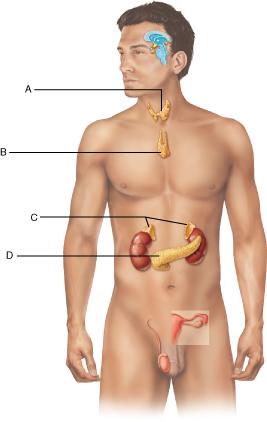
Identify the thyroid gland. Select from letters A-D.
A
What is the primary function of hormones?
A) Cause allergic reactions
B) Alter cell activity
C)
Stimulate meiosis
D) Activate extracellular enzymes
B) Alter cell activity
Which of the following mechanisms of hormone action is used by neurotransmitters and olfactory receptors?
A) ATP
B) GTP
C) cAMP
D) G protein
C) cAMP
__________ is the situation when one hormone cannot exert its full effects without another hormone being present.
A) Antagonism
B) Permissiveness
C) Activism
D) Synergism
B) Permissiveness
The stimuli causing endocrine glands to secrete their hormones in direct response to changing blood levels of certain critical ions and nutrients are called __________.
A) Neural stimuli
B) Humoral stimuli
C) Hormonal stimuli
D) Endocrinal stimuli
B) Humoral stimuli
True or False?
Up-regulation involves the loss of receptors and prevents the target cells from overreacting to persistently high hormone levels.
FALSE
True or False?
The hypothalamus is known to control the activity of the anterior pituitary, which has traditionally been called the "master endocrine gland."
TRUE
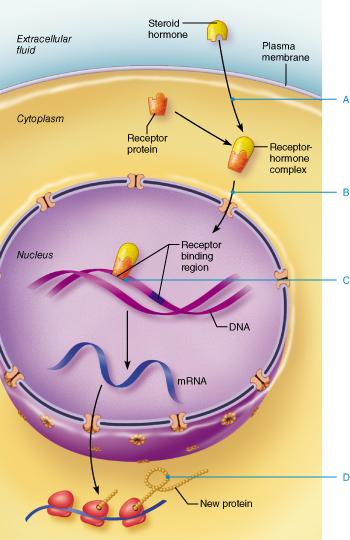
At which point does the hormone bind to its intracellular receptor? Determine the receptor-hormone complex. Select from letters A-D.
A

What amino acid-based hormone uses the direct gene activation method illustrated in this image?
thyroxine
Hyperprolactinemia may be caused by?
A) Hypersecretion of dopamine
B) Hypersecretion of
GHRH
C) Lack of negative feedback by insulin
D) Decreased
secretion of renin
A) Hypersecretion of dopamine
What is required for the production of anterior pituitary gland hormones?
A) Humoral stimuli
B) Hormonal stimuli
C) Neural stimuli
(from the sympathetic division of the ANS)
D) All of these
A) Humoral stimuli
Hormones that regulate the secretory action of other endocrine glands are called __________.
A) Somatotropin
B) Somatostatins
C) Tropins
D) GHIH
C) Tropins

What hormone released into the blood (shown by letter D) by the posterior pituitary inhibits or prevents urine formation?
A) Norepinephrine
B) Thyroxine
C) Prolactin
D)
Antidiuretic hormone (ADH)
D) Antidiuretic hormone (ADH)
Hypersecretion of what hormone can produce the effects of gigantism?
A) thyroid hormones (TH)
B) thyroid-stimulating hormone
(TSH)
C) growth hormone (GH)
D) aldosterone
C) growth hormone (GH)
What gland secretes growth hormone?
A) anterior pituitary (lobe)
B) posterior pituitary
(lobe)
C) adrenal cortex
D) thyroid gland
A) anterior pituitary (lobe)
You would predict that iodized salt would have no effect on any cases of ____________.
A) cretinism
B) Graves' disease
C) endemic goiter
D) myxedema
B) Graves' disease
Which hormone is the body's major metabolic hormone?
A) thyroid hormone
B) parathyroid hormone
C)
adrenocorticotropic hormone
D) antidiuretic hormone
A) thyroid hormone
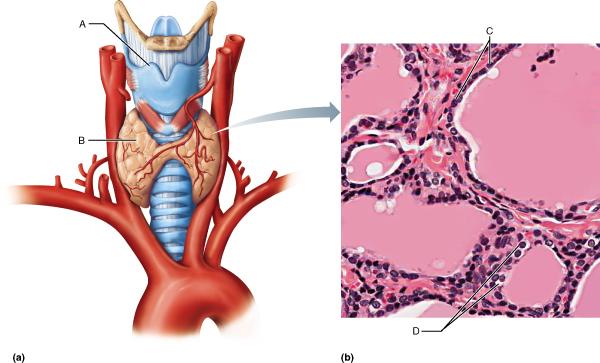
What type of cell is shown at letter C?
Follicular cells

What hormone is released by the cells pictured in letter D?
Calcitonin
True or False?
Osteitis fibrosa is a rare complication of hyperparathyroidism where the bones soften and deform.
TRUE
Aldosteronism will cause ______.
A) Decreased secretion of renin
B) Decreased secretion of ANP
(atrial naturetic peptide)
C) Decreased loss of K+ in the
urine
D) None of the listed responses is correct.
A) Decreased secretion of renin
Cushing's syndrome and aldosteronism have the same effects on ______.
A) blood pressure
B) gluconeogenesis
C) plasma glucose
levels
D) All of the listed responses are correct.
A) blood pressure
Which hormone(s) is/are essential to our ability to deal with stress?
A) insulin
B) thyroxine
C) glucocorticoids
D) mineralocorticoid
C) glucocorticoids
Which of the following adrenal gland homeostatic imbalances is characterized by persistent elevated blood glucose levels, dramatic losses in muscle and bone protein, and water and salt retention, leading to hypertension and edema?
A) cretinism
B) Addison's disease
C) Graves'
disease
D) Cushing's syndrome
D) Cushing's syndrome
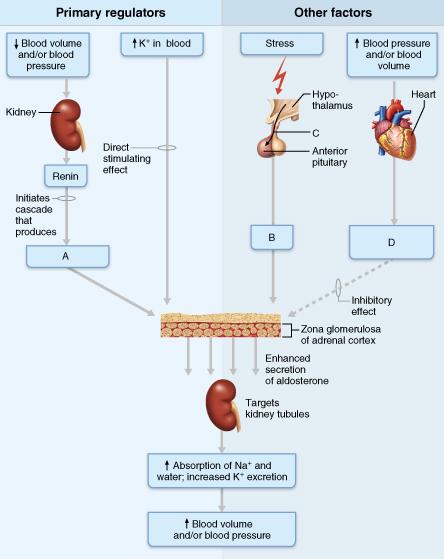
What hormone, notated by letter B, is released by the anterior pituitary to target the adrenal cortex when we are under stress?
A) parathyroid hormone
B) aldosterone
C)
adrenocorticotropic hormone (ACTH)
D) Insulin
adrenocorticotropic hormone (ACTH)
One can predict that a person suffering from diabetes mellitus would probably have ______.
A) increased secretion of ANP (atrial natiuretic peptide)
B)
increased secretion of ADH (anti-diuretic hormone)
C) decreased
secretion of catecholamines
D) decreased secretion of PTH
(parathyroid hormone/parathormone)
B) increased secretion of ADH (anti-diuretic hormone)
Which of the following is NOT a property of endocrine glands?
A) They have ducts
B) They drain vascularly
C) They drain lymphatically
D) They produce hormones.
A) They have ducts
Which of the following is not an endocrine gland?
A) Pituitary gland
B) Thyroid gland
C) Adrenal
gland
D) Adenoid gland
D) Adenoid gland

Which letter represents the adrenal glands? Select from letters A-D.
C

Identify the pancreas. Select from letters A-D.
D
Which of the following is NOT a major type of stimulus that triggers endocrine glands to manufacture and release hormones?
A) enzymatic
B) hormonal
C) neural
D) humoral
A) enzymatic
Which of the following occurs in situations where more than one hormone produces the same effects at the target cell and their combined effects are amplified?
A) antagonism
B) synergism
C) permissiveness
D) summation
B) synergism

At what point does the receptor-hormone complex bind to DNA? Select from letters A-D.
C
A blow to the head may cause diabetes insipidus by ______.
A) triggering the hypersecretion of hypothalamic-inhibiting
hormones
B) triggering the hyposecretion of
hypothalamic-inhibiting hormones
C) interfering with the normal
transmission of ADH to the posterior pituitary via the axons of
hypothalamic neurons
D) causing hypersecretion of ADH
C) interfering with the normal transmission of ADH to the posterior pituitary via the axons of hypothalamic neurons
Acromegaly may be caused by all EXCEPT which of the following?
A) hypersecretion of GHRH (growth hormone-releasing hormone)
B) pancreatic tumor
C) lack of negative feedback by insulin-like growth factors
D) positive feedback by GH (growth hormone) on the anterior pituitary
D) positive feedback by GH (growth hormone) on the anterior pituitary
Which of the following is a hormone produced by the posterior pituitary?
A) ADH
B) Oxytocin
C) FSH
D) none of these
D) none of these
Which of the following hormones stimulates the adrenal cortex to release glucocorticoids that help the body to resist stressors?
A) adrenocorticotropic hormone
B) follicle-stimulating
hormone
C) prolactin
D) thyroid-stimulating hormone
A) adrenocorticotropic hormone
Which of the following hormones mainly serves to stimulate milk production by the breasts?
A) thyroid-stimulating hormone
B) follicle-stimulating
hormone
C) prolactin
D) adrenocorticotropic hormone
C) prolactin
True or False?
Major hormones circulate to virtually all tissues.
TRUE
True or False?
The anatomical effects of acromegaly can usually be reversed by surgically removing the tumor from the anterior pituitary.
FALSE

Where are the hormones oxytocin and antidiuretic hormone (ADH) stored? Select from letters A-D.
C
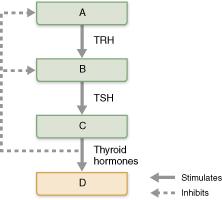
What is the target organ of thyroid-stimulating hormone (TSH)? Select from letters A-D.
C

What is the target organ of thyroid-releasing hormone (TRH)? Select from letters A-D.
B
Which of the following is NOT a homeostatic imbalance related to underactivity of the thyroid gland?
A) endemic goiter
B) Graves' disease
C) myxedema
D) cretinism
B) Graves' disease

Name two hormones produced by the gland identified by letter B
thyroid hormones and calcitonin
Hypocalcemia could be caused by the ______.
A) apoptosis of parathyroid cells
B) failure of osteoclasts to
respond to PTH (parathyroid hormone/parathormone)
C) malfunction
of the parathormone receptors in kidney tubule cells
D) All of
the listed responses are correct.
D) All of the listed responses are correct.
Which of the following hormones regulates blood calcium ion levels?
A) luteinizing hormone
B) thyroid hormone
C) parathyroid hormone
D) follicle-stimulating hormone
E) insulin
C) parathyroid hormone
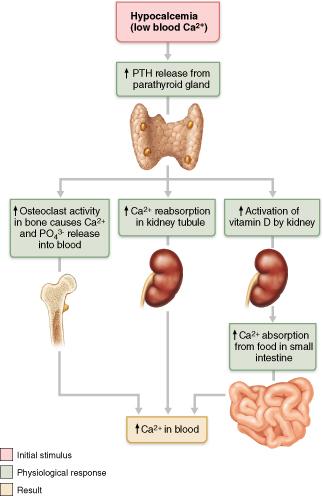
What type of stimulation controls parathyroid release?
humoral

What cells release parathyroid hormone?
parathyroid cells
Which of the following glands is found atop the kidneys?
A) adrenal
B) thyroid
C) parathyroid
D) pituitary
A) adrenal

What factor inhibits aldosterone release? Select from letters A-D.
D

Which letter represents the hormone that promotes a decrease in blood pressure and a loss of sodium and water in urine? Select from letters A-D.
D
Which pancreatic hormone functions to lower blood glucose levels?
A) somatostatin
B) glucagon
C) gastrin
D) insulin
D) insulin
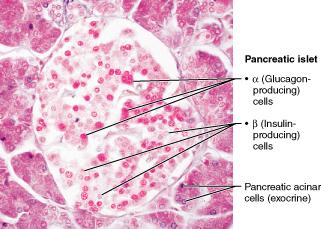
Which of the following best describes the main effects of insulin?
lower blood glucose levels

Which of the following is a hypoglycemic hormone?
Insulin

Which hormone is involved in diabetes mellitus (DM)?
Insulin
True or False?
Hormones are long-distance chemical signals that travel in blood or lymph throughout the body.
True
True or False?
Nitric oxide is known to be the first gas to act as a biological messenger.
True
Which hormone directs essentially all the events of the
absorptive state?
A) Adrenaline
B) Growth
Hormone
C) Glucagon
D) Insulin
D) Insulin
True or False?
Most ATP in cellular respiration is generated in glycolysis.
FALSE
True or False?
The body is able to form glucose from non-carbohydrate precursors.
TRUE
Sometimes prolonged exessive exposure to high hormone concentrations causes a phenomenon known as?
A) Metabolism of protein kinases
B) Cellular
inhibition
C) Down regulation
D) Diabetes Mellitus
C) Down regulation
Insulin promotes all the following EXCEPT?
A)
Gluconeogenesis
B) Protein synthesis
C) Lipogenesis
D) Glycogenesis
B) Protein synthesis